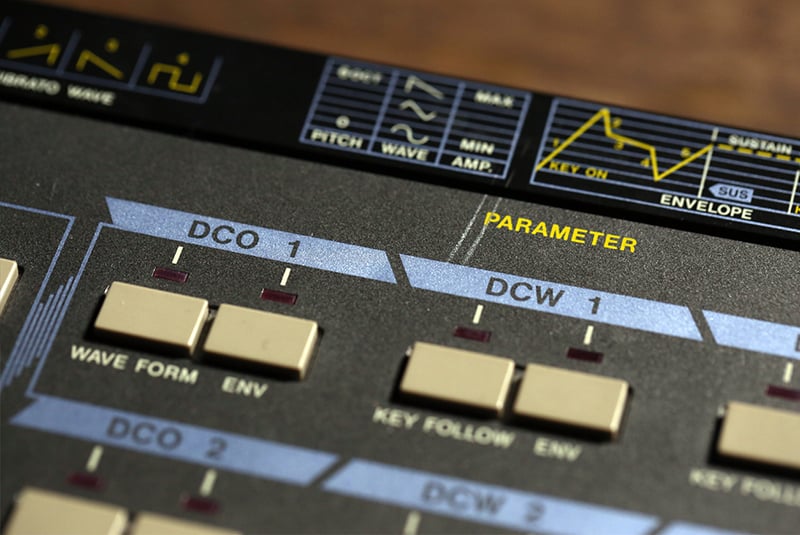Phase Distortion (PD) and Frequency Modulation (FM) techniques emerged from a desire to subvert the limitations imposed by traditional subtractive synthesis approaches. The techniques themselves involve digital transformations of otherwise simple waveforms in order to produce complex sounds. Both PD and FM utilize “table lookup” oscillators, which use a counter to select the specific point to-be-read in order to spawn the phase of the waveform. From there, the methodology can remain relatively simple (PD) or decidedly complex (FM).
Phase Distortion
Phase Distortion was introduced and popularized via Casio’s acclaimed CZ series, itself borne out of a desire to produce a democratized synthesizer that could accomplish the sounds afforded by analog-based subtractive synthesis.
Despite being the simpler of the two approaches, PD is more than capable of yielding sophisticated results. To put it succinctly, PD is a wavetable-based technique involving the manipulation of a waveform’s playback rate within a predetermined cycle.
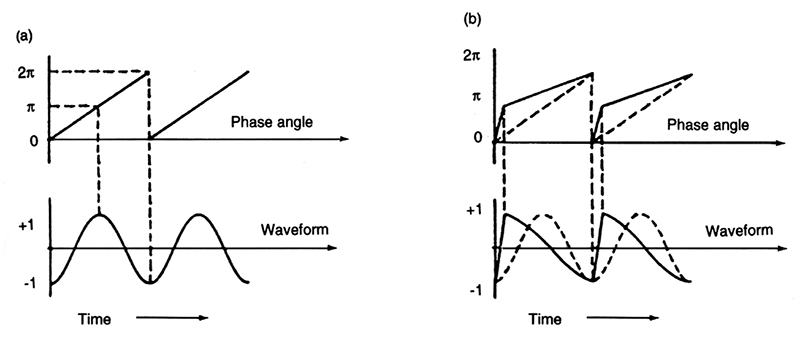
PD typically uses Direct Digital Synthesis (DDS) oscillators—that is, oscillators mobilized by a phase accumulator counter that is itself advanced by a frequency increment simultaneously indexing a lookup table. Altering the shape of the accumulator results in distortion whenever the function achieves a non-linear state. Here, harmonic fluctuations are introduced into the signal without affecting the waveform’s frequency. Due to this configuration, Phase Distortion can easily emulate the variable resonance typical of analog VCFs.
DCW and Resonant Waveforms
Casio’s CZ synthesizers yield five traditional waveforms—square, sawtooth, pulse, double sine, half sine—and three “resonant waveforms” consisting of sawtooth, triangle, and trapezoidal shapes. These latter waveforms utilize hard-sync to produce a simulated filter response that sounds remarkably close to a true analog filter. A corresponding Digitally-Controlled Waveshaping control allows for expedient morphing between all eight waveshapes—and in the case of the latter three it repositions the resonant peak above the fundamental frequency.
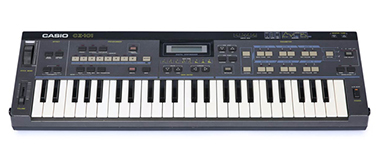 Casio CZ-101, pioneer of phase distortion
Casio CZ-101, pioneer of phase distortion
Here lies one of the largest advantages of PD as it relates to FM: since the waveshape of the modulator is not restricted to a bare sine wave, as is the case with FM, it can be modified to achieve complex results with fewer resources than FM.
Modern Phase Distortion Synthesizers
Like the CZ series, modern devices have incorporated square, sawtooth, cosine, and triangle waveforms as well, carving plenty of avenues for unique sonic experimentation. WMD’s PDO oscillator module is an excellent example of modernized PD synthesis. It features intricate phase input routing and a set of phase offset controls that allow for precise manipulation of the relative phase across each channel.
Frequency Modulation
FM is usually perpetrated by DDS oscillators operating in tandem in a Carrier/Modulator configuration. Sound is produced as a result of the output of the Modulator modulating the frequency of the Carrier. However, unlike PD, the phase portion of this process remains distortion-free. Rather, the tuning ratio between the two oscillators is one of the most crucial parameters as defining the tuning ratio has a dramatic input on timbre.
FM also differs from PD in that each oscillator contains its own integrated envelope. The envelopes affect different parameters depending on what particular device is being used; in Yamaha’s DX7 synthesizer, the envelopes modulated the intensity of modulation between Modulator and Carrier and can also be assigned to modulate the pitch of the Modulators. Combined, the oscillator-envelope pairing is called an Operator. Most FM-oriented synthesizers have more than two operators—for example, the DX7 has six—which can be arranged in a number of ways for different flavors of modulation.
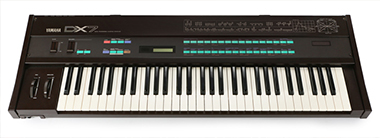 Yamaha's DX7 synthesizer is an FM powerhouse
Yamaha's DX7 synthesizer is an FM powerhouse
FM Algorithms
One of the most intriguing aspects of FM synthesizers is the selection of algorithms. An algorithm is essentially equivalent to frequency modulation routing. Within the context of the algorithm each operator uses its waveform to perform one of two possible functions.
When configured as a Carrier, an operator’s waveform is output directly to an external amplification source. Conversely, when configured as a Modulator, the operator alters the waveform of the next subsequent operator. If a carrier is connected to one or more operators, then the resulting waveform will be altered prior to amplification. This configuration means that the algorithmic structure directly affects the function of each operator. For that reason, knowing which algorithm to select is one of the keys to compelling sound design.
 The DX7's four algorithm configurations
The DX7's four algorithm configurations
Yamaha’s DX7 enjoys a solid selection of FM algorithms, which can be yoked down to four primary configurations: Stacked, Branched, Root, and Carrier-Only algorithms. A Stacked algorithm involves at least one modulator connected in series to one carrier; multiple stacks can be arranged in parallel within a single Stacked algorithm. Branched algorithms consist of multiple modulators connected to one carrier. Root algorithms constitute just the opposite: one modulator is connected to multiple carriers. Finally, Carrier-Only algorithms feature a multitude of carriers; the DX7’s classic organ tones exploit this algorithm to the fullest.
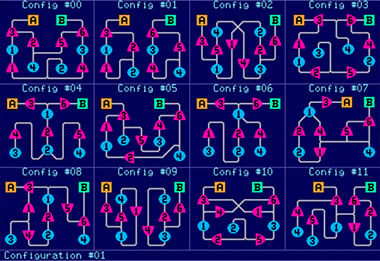 FM configurations from the Buchla 700
FM configurations from the Buchla 700
Yamaha's extensive DX and TX series were not the only 1980s synthesizers to offer explorations into digital FM: even boutique manufacturers such as Buchla & Associates dabbled with their own implementations of DX-like topologies. The Buchla 700 was a peculiar workstation and performance instrument somewhere between a DX7, Synclavier, and Music Easel. Its voice architecture was largely concerned with complex DX-like FM arrangements, which Buchla & Associates called "configurations" rather than "algorithms”.
Linear and Exponential FM
Many modern synthesizers are equipped with linear FM capabilities. This means that the modulator alters the frequency in identical increments above and below the operator’s current level—as above so below, as the saying goes. This allows for better tracking and is more subdued than its counterpart. Exponential FM, on the other hand, is much more chaotic and often results in pitch drift at higher modulation indices.
Modern FM Synthesizers
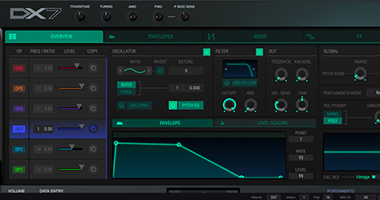 The tactile interface of Arturia's DX7 V plugin
The tactile interface of Arturia's DX7 V plugin
Where PD is relatively straightforward, FM demands precise frequency settings for each operator, resulting in an inherently complicated setup process. Many early FM synthesizers, such as the DX7, are notoriously difficult to program primarily due to the limitations imposed by their hardware interfaces. Fortunately, many modern FM synthesizers and plugins have consciously sidestepped this arduousness. A good example is Arturia’s DX7 V plugin. Featuring the same great sounds behind a fully modernized interface, DX7 V makes programming FM fast and fun. A quick glance at DX7 V’s operator and envelope windows reveals its inherent intuitiveness. Rather than a constricted screen with minimal display information, DX7 V’s interface displays all relevant parameters. In the case of the envelope and operator pages specifically, motion graphics facilitate an immediacy that is simply not possible with the DX7 itself!
However, the ease-of-use mobilization of FM technology is not strictly limited to software. The past decade has ushered the reign of several resolutely powerful FM-oriented synthesizers, such as Korg’s Volca FM and Elektron’s Digitone. Volca FM is a 3-voice polyphonic synthesizer with an integrated sequencer and the capability to load SysEx files intended for use with the DX7 itself, menaing users can transfer DX7 preset files straight into the Volca FM! Digitone is a modernized FM synthesizer equipped with Elektron’s unique sequencer and a stunning array of effects. Users can select from a plethora of FM algorithms and subsequently arrange them in a variety of configurations to create powerful progressions. Digitone demystifies the complicated nature FM with its comprehensive UI and thoughtful visual feedback scheme.
When PD Meets FM
With the Casio CZ Series and Yamaha DX Series carving the path, subsequent Phase Distortion and Frequency Modulation endowed synthesizers have cauterized the trajectory with even more sophistication. Case in point, the Hertz Donut mk3 from Industrial Music Electronics. This module is the bastard spawn of painstaking research and an intricate understanding of the nuances of both PD and FM. Consequently, it mercilessly executes either at will, separately or in tandem, leaving the modern synthesist with no room for anything except sordid sonic deviancy. Compared to previous PM synthesizers, the Hertz Donut’s interface is decidedly ergonomic, facilitating tactile slider-controlled operation over its most essential controls while an adjacent OLED screen provides immediate visual apprehension of all parameters.
Analog FM
Despite its current association with the digital realm, the first FM implementations were analog. To this point, there are plenty of modern analog oscillators that produce delectable results when subjected to frequency modulation, including Intellijel’s Rubicon mk2, Make Noise’s DPO, and Plan B’s coveted Model 15 VCO.
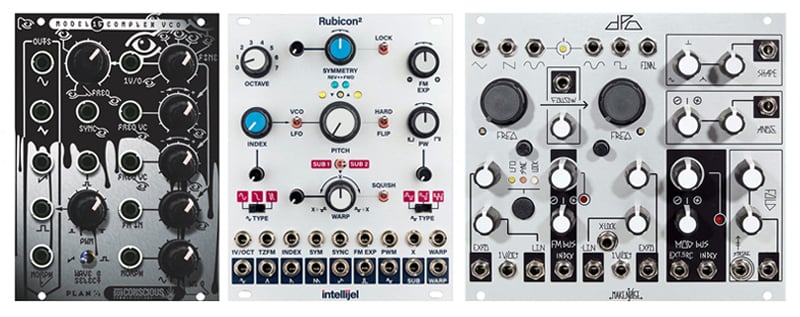
Want to learn more about FM? We’ll be releasing a comprehensive article in the future that tackles that concept more exclusively. Until then, enjoy this awesome video featuring the Casio CZ-101, Elektron Digitone, and Korg Volca FM.

